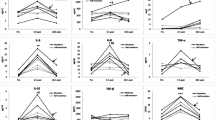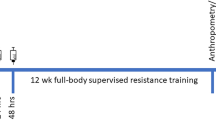Abstract
Purpose
Acute and chronic physical exercise is believed to have beneficial effects on human health. Exercise is also able to modulate immune function. We hypothesed that exercise is able to induce many benefits for human health by modulating immune functions through the production and release of many myokines. Here, we investigated the effects of a running race on the level of plasmatic myokines.
Methods
Nine male volunteers took part in this study. Blood samples were obtained before, immediately after and 24 h after the race.
Results
Participants completed the 10 km running race in 49.85 ± 7.04 min. The levels of IL-6 elevated after exercise (0.94 ± 0.4–2.82 ± 0.3 pg/ml). The IL-15 plasma level was also higher immediately after (0.88 ± 0.25–1.29 ± 0.36 pg/ml), and 24 h after (1.30 ± 1.01 pg/ml), the end of the exercise. Irisin increased only 24 h after exercise (632.60 ± 188.40–974.70 ± 232.30 pg/ml). FABP3 increased after exercise (829.60 ± 68.93–1306.00 ± 319.10 pg/ml). The plasma levels of BDNF (4719.00 ± 701.80–5557.00 ± 810.30 pg/ml) and Fractalkine increased after exercise (101.2 ± 34.96–134.90 ± 43.62 pg/ml). The level of FSTL (7265.00 ± 1553.00–9074.00 ± 1662.00 pg/ml) and Osteonectin (16.52 ± 3.54–15.71 ± 3.38 pg/ml) also increased after exercise, and then returned to baseline level 24 h after the end of the session.
Conclusion
Taken together, these results suggest that a 10 km running race induces elevation of important myokine plasma levels.





Similar content being viewed by others
References
McArdle WD, Katch FI, Katch VL (2011) Fisiologia do Exercício: energia, nutrição e desempenho humano. Editora Guanabara Koogan, Sétima edição
Pedersen BK, Hoffman-Goetz L (2000) Exercise and the immune system: regulation, integration, and adaptation. Physiol Rev 80(3):1055–1081
Pedersen BK, Febbraio MA (2012) Muscles, exercise and obesity: skeletal muscle as a secretory organ. Nat Rev Endocrinol 8(8):457–465
Gleeson M (2007) Immune function in sport and exercise. J Appl Physiol 103(2):693–699
Rabin BS Moyna MN, Kusnecov A, Zhou D, Shurin MR (1996) Neuroendocrine effects of immunity. Exerc Immune Funct 21–38
Huh JY (2018) The role of exercise-induced myokines in regulating metabolism. Arch Pharm Res 41(1):14–29
Pedersen BK, Febbraio MA (2008) Muscle as an endocrine organ: focus on muscle-derived interleukin-6. Physiol Rev 88(4):1379–1406
Nunes-Silva A, Matos JM, Freitas-Lima LC, Gomes EC, Nogueira-Machado JA, Vieira ELM et al (2018) Intense aerobic exercise modifies leucocytes number, lymphocyte subpopulation and cytokine levels in peripheral blood. Gazzetta Medica Italiana Archivio per le Scienze Mediche 177(3):79–87
Schnyder S, Handschin C (2015) Skeletal muscle as an endocrine organ: PGC-1α, myokines and exercise. Bone 80:115–125
Chen YJ, Wong SHS, Chan COW, Wong CK, Lam CW, Siu PMF (2009) Effects of glycemic index meal and CHO-electrolyte drink on cytokine response and run performance in endurance athletes. J Sci Med Sport 12(6):697–703
Bishop NC, Walsh NP, Haines DL, Richards EE, Gleeson M (2001) Pre-exercise carbohydrate status and immune responses to prolonged cycling: II. Effect on plasma cytokine concentration. Int J Sport Nutr Exerc Metabol 11(4):503–512
Rinnov A, Yfanti C, Nielsen S, Åkerström TCA, Peijs L, Zankari A et al (2014) Endurance training enhances skeletal muscle interleukin-15 in human male subjects. Endocrine 45(2):271–278
Lammers G, Poelkens F, Duijnhoven NTL, Pardoel EM, Hoenderop JG, Thijssen DHJ et al (2012) Expression of genes involved in fatty acid transport and insulin signaling is altered by physical inactivity and exercise training in human skeletal muscle. Am J Physiol Endocrinol Metabol 303(10):E1245–E1251
Roca-Rivada A, Castelao C, Senin LL, Landrove MO, Baltar J, Crujeiras AB et al (2013) FNDC5/irisin is not only a myokine but also an adipokine. PLoS One 8(4):e60563
Kim KH, Kim SH, Min YK, Yang HM, Lee JB, Lee MS (2013) Acute exercise induces FGF21 expression in mice and in healthy humans. PLoS One 8(5):e63517
Gaich G, Chien JY, Fu H, Glass LC, Deeg MA, Holland WL et al (2013) The effects of LY2405319, an FGF21 analog, in obese human subjects with type 2 diabetes. Cell Metab 18(3):333–340
Roh HT, Cho SY, Yoon HG, So WY (2017) Effect of exercise intensity on neurotrophic factors and blood-brain barrier permeability induced by oxidative-nitrosative stress in male college students. Int J Sport Nutr Exerc Metab 27(3):139–146
Perjés Á, Skoumal R, Tenhunen O, Kónyi A, Simon M, Horváth IG, Kerkelä RR et al (2014) Apelin increases cardiac contractility via protein kinase Cε-and extracellular signal-regulated kinase-dependent mechanisms. PLoS One 9(4):e93473
Kharraz Y, Guerra J, Mann CJ, Serrano LA, Muñoz-Cánoves P (2013) Macrophage plasticity and the role of inflammation in skeletal muscle repair. Med Inflamm 2013:9
Metcalf D (2003) The unsolved enigmas of leukemia inhibitory factor. Stem Cells 21(1):5–14
Broholm C, Mortensen OH, Nielsen S, Akerstrom T, Zankari A, Dahl B et al (2008) Exercise induces expression of leukaemia inhibitory factor in human skeletal muscle. J Physiol 586(8):2195–2201
Krist J, Wieder K, Klöting N, Oberbach A, Kralisch S, Wiesner T et al (2013) Effects of weight loss and exercise on apelin serum concentrations and adipose tissue expression in human obesity. Obesity Facts 6(1):57–69
Kadoglou NPE, Vrabas IS, Kapelouzou A, Lampropoulos S, Sailer N, Kostakis A et al (2012) The impact of aerobic exercise training on novel adipokines, apelin and ghrelin, in patients with type 2 diabetes. Med Sci Monit 18(5):CR290–CR295
Görgens SW, Raschke S, Holven KB, Jensen J, Eckardt K, Eckel J (2013) Regulation of follistatin-like protein 1 expression and secretion in primary human skeletal muscle cells. Arch Physiol Biochem 119:75–80
Jørgensen LH, Petersson SJ, Sellathurai J, Andersen DC, Thayssen S, Sant DJ et al (2009) Secreted protein acidic and rich in cysteine (SPARC) in human skeletal muscle. J Histochem Cytochem 57(1):29–39
Hoffmann C, Weigert C (2017) Skeletal muscle as an endocrine organ: the role of myokines in exercise adaptations. Cold Spring Harbor Perspect Med. https://doi.org/10.1101/cshperspect.a029793
Fortunato AK, Pontes WM, De Souza DMS, Prazeres JSF, Marcucci-Barbosa LS, Santos JMM, Da Silva AN (2018) Strength Training Session induces important changes on physiological, immunological, and inflammatory biomarkers. J Immunol Res. https://doi.org/10.1155/2018/9675216
Author information
Authors and Affiliations
Corresponding author
Ethics declarations
Conflict of interest
The authors declare that they have no conflict of interest.
Ethical approval
All procedures performed in studies involving human participants were in accordance with the ethical standards of the institutional research committee (Santa Casa Hospital in Belo Horizonte, MG, Brazil (466/2012) n. 074/2007.) and with the 1964 Helsinki declaration and its later amendments or comparable ethical standards.
Informed consent
Written informed consent was obtained from all individual participants included in the study.
Additional information
Publisher's Note
Springer Nature remains neutral with regard to jurisdictional claims in published maps and institutional affiliations.
Rights and permissions
About this article
Cite this article
Marcucci-Barbosa, L.S., Martins-Junior, F., Lobo, L.F. et al. 10 km running race induces an elevation in the plasma myokine level of nonprofessional runners . Sport Sci Health 16, 313–321 (2020). https://doi.org/10.1007/s11332-019-00608-3
Received:
Accepted:
Published:
Issue Date:
DOI: https://doi.org/10.1007/s11332-019-00608-3




